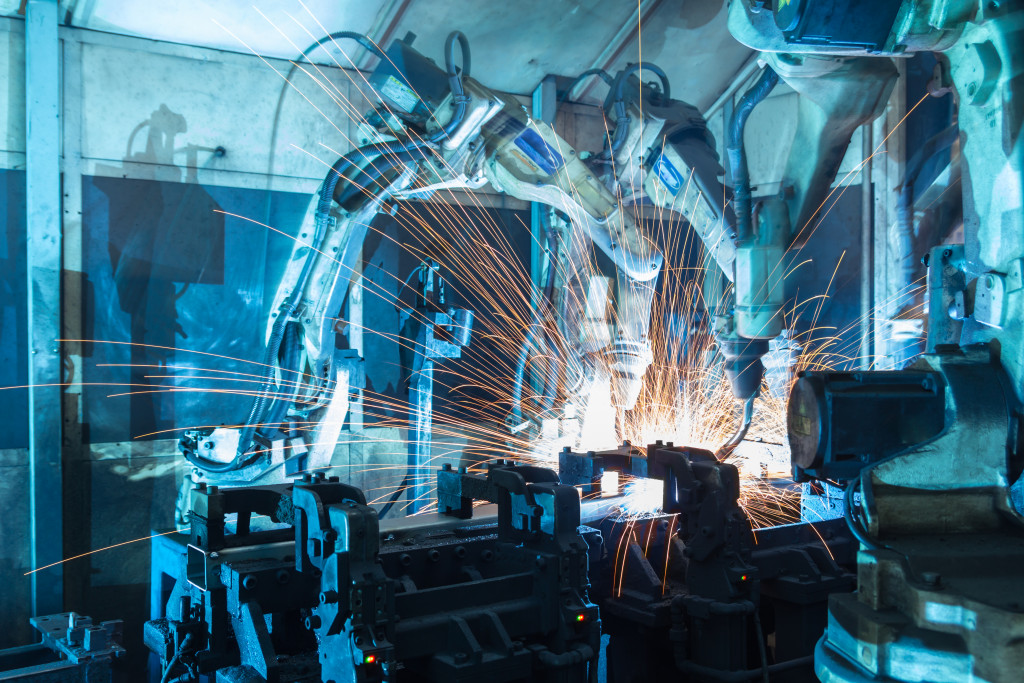- Automation in modern manufacturing processes helps reduce labor costs, increase efficiency, and improve product quality.
- Robotic arms are a great automation tool, enabling businesses to automate complex and delicate processes with accuracy and speed.
- Statistical process control software helps identify any inconsistencies or defects in products early on.
- Predictive maintenance solutions allow manufacturers to proactively identify potential areas for improvement and plan for parts replacements.
Automation has become an integral part of modern manufacturing processes. It has enabled businesses to reduce costs, increase efficiency, and improve the quality of their products. Automation also helps to reduce labor costs by eliminating the need for manual labor and streamlining production lines.
According to the International Federation of Robotics (IFR), worldwide sales of industrial robots grew 10% in 2022 — totaling nearly 430,000 units sold during that year alone. This growth is primarily attributed to the increasing demand for automation among manufacturers across various sectors and industries.
However, you might not know the proper applications for automation in manufacturing. Here are some of the best applications of automation in modern industrial settings:
Robotic Arms

Robotic arms provide a great advantage to manufacturing applications, enabling businesses to automate complex and delicate processes accurately and quickly. This automation helps reduce labor costs, ensuring that tasks are done quickly and efficiently. Additionally, robotic arms can help increase safety in the workplace by minimizing human contact with hazardous materials. Here are some of the essential advantages and applications of robotic arms in manufacturing:
Reduced Labor Costs
Robotic arms can reduce the need for manual labor, allowing businesses to save on costly labor costs. Automation also ensures consistent production output while eliminating downtime associated with traditional manual processes.
Increased Efficiency
Robotic arms can provide more consistent results than manual processes. This increased efficiency ensures that products consistently meet quality standards and reduces production times significantly. Furthermore, robots can be programmed to handle multiple tasks simultaneously, allowing manufacturers to produce products at higher volumes over shorter periods.
Improved Quality Control
Robotic arms allow manufacturers to ensure uniformity in product quality by enabling them to conduct precision measurements or inspections on each item produced. This improved quality control helps manufacturers stay competitive by increasing customer satisfaction while minimizing faulty products or returns costs.
Packaging Applications
Robotic arms are beneficial for packaging tasks such as labeling boxes or sealing plastic bags. As these tasks require precise hand-eye coordination, robots can perform them more accurately than humans without sacrificing speed or consistency. Furthermore, robots can be used for palletizing operations that involve heavy lifting or assembly line tasks that require repetitive motion — again reducing costs while increasing safety in the workplace.
Quality Control

Automating quality control processes can help businesses reduce labor costs, increase efficiency, and ensure products meet quality standards consistently. Automation in quality control ensures uniformity across all products and helps quickly identify any inconsistencies or defects. This allows businesses to be more proactive in their approach to product safety and customer satisfaction by reducing the risk of faulty products entering the market.
Furthermore, automated solutions for quality control reduce labor costs associated with manual inspection processes, allowing businesses to allocate resources toward other production tasks. Finally, automating these processes reduces downtime associated with inspecting individual items manually and increases productivity, as robots can work faster than humans. Overall, automation in manufacturing is an excellent way for businesses to optimize productivity while ensuring consistent product quality.
You can also invest in statistical process control software to ensure that manufacturing processes meet quality standards. Statistical process control helps to identify any inconsistencies or defects in products early on, allowing businesses to take corrective action quickly while minimizing losses associated with faulty products.
Predictive Maintenance
Predictive maintenance solutions allow businesses to identify potential areas for improvement in their manufacturing processes proactively. With predictive analytics, manufacturers can detect issues early on and take corrective action before they become problematic. This helps them avoid costly downtime associated with unexpected repairs or replacements of components.
Predictive maintenance allows businesses to plan and schedule preventive maintenance tasks at optimal times, saving time and money. For example, with predictive maintenance, manufacturers can prepare for parts that may need to be replaced in the future and order them before failure. This helps them avoid any disruptions associated with downtime due to unplanned repairs.
Final Thoughts
Automation in manufacturing is becoming increasingly important as businesses look to optimize their processes while remaining competitive. With suitable applications, automation can help reduce labor costs, increase efficiency, and improve product quality. By investing in automated solutions like robotic arms, predictive maintenance software, and statistical process control solutions — manufacturers can ensure that their products meet quality standards while minimizing disruptions associated with downtime.

